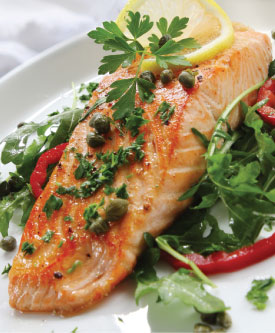Choosing sustainable and healthy seafood
by Eli Penberthy
This article was originally published in June 2009

(June 2009) — Choosing seafood that is both sustainable and healthy can be challenging. Is it farmed or wild? Troll-caught or trawled? Alaskan or Chilean? Healthy or toxic? There are so many questions — it’s enough to confuse even the most conscientious consumer.
At PCC, we make it easy by providing only seafood from environmentally sustainable fisheries — and we don’t carry seafood with unsafe levels of PCBs, mercury or other contaminants. We consult with the Monterey Bay Aquarium Seafood Watch program and the Environmental Defense Fund (EDF) to ensure our seafood meets strict environmental and health standards.
Greenpeace USA has rated PCC higher than any other grocer in the United States for our sustainable seafood policies and initiatives. We received a 9 out of 10 score (93 percent, to be exact). As of December 2008, other local retailers didn’t fare nearly as well; Whole Foods scored 5/10 and Trader Joe’s 1/10.
A good rule of thumb is to buy local, wild and fresh seafood, but you may be surprised to learn that some varieties of fish are sustainable even if they’re farmed. Farmed sturgeon, mussels, oysters and scallops, for example, are considered sustainable choices by the Seafood Watch program. Some of these species even improve water quality!
Similarly, canned or jarred seafood can be as good or better than fresh. Light tuna, salmon, anchovies and sardines are less expensive than fresh or frozen, available year-round, and convenient for quick, easy meals. Anchovies and sardines have even more omega-3 fatty acids than salmon!
Canned tuna is very complicated. Like our decision to ban high fructose corn syrup, what we don’t carry says as much about our values as what we do. The sustainability of tuna is determined by its specific geography, the fishing method, and the species — and we’re discontinuing brands that do not meet the same sustainability standards as our seafood.
We’re using this as an opportunity to source more local and sustainable varieties that are troll-caught, have low mercury levels, and are caught in the Pacific Northwest, such as Sweet Creek, Tuna Guys and Pelican’s Choice.
Sustainable … and healthy
Following Monterey Bay Aquarium’s guidelines allows us to choose sustainable seafood, but we then additionally cross-check those recommendations against the health risk advisories for various fish. Mercury, Polychlorinated Biphenyls (PCBs) and other contaminants can be a concern.
Mercury is a toxic metal that often is concentrated in large fish at the top of the marine food chain, such as tuna, mackerel, swordfish and shark. PCBs are carcinogenic chemicals that accumulate in large fish, such as salmon. They’re not highly toxic in a single meal but continued exposure over time can be harmful to health.
PCC considers guidelines from the Food and Drug Administration (FDA) and the Environmental Protection Agency and consults with scientists at EDF to set guidelines for how much seafood you and your family can consume safely. Our new brochure outlines the varieties of fish we carry, the potential for contamination, and the amount we may eat each month. Download a PDF of our seafood brochure »
We never sell seafood that’s likely to be highly contaminated, including swordfish, tilefish, shark or mackerel — even if it’s from sustainable fisheries. Much of the seafood we do carry — including cod, crab, mussels, scallops, clams, anchovies, oysters, Oregon pink shrimp and spot prawns — have no known health risks.
Benefits and risks
Whether the risks of eating seafood outweigh the benefits — even for pregnant women and children — is a matter of scientific debate. In 2004 the FDA issued an advisory suggesting that pregnant women, nursing mothers and children choose seafood low in mercury and eat no more than 12 ounces, or about two meals, of seafood per week (including no more than 6 ounces of albacore tuna).
But some studies have found that children whose mothers eat at least three servings of fish a week during pregnancy perform better on tests of intelligence and motor skills, and claim that limiting fish intake to the level recommended by the FDA could be counterproductive. One study at Harvard Medical School even concluded that women who ate about 14 ounces of fish per week during pregnancy had children with 30 percent likelihood of better development.
For adults, the health benefits of eating seafood are even more compelling. A 2006 Harvard study found that modest consumption of seafood can reduce the risk of death from heart disease by 36 percent and can reduce death from any cause by 17 percent.
“The levels of PCBs and dioxins in fish species are low, similar to other commonly consumed food products such as beef, chicken, pork, eggs and butter,” said Dariush Mozaffarian, the study’s author.
Seafood truly is a nutritional powerhouse. In addition to having omega-3s, it’s high in protein, low in fat and sodium, and a great source of vitamins, minerals and other nutrients. Small fish, such as sardines and smelts, and canned salmon, are rich in calcium.
To maximize the health benefits and minimize the risks, a reasonable guideline is to eat a variety of sustainable seafood about twice a week. If you have children, simply feed them smaller portions.
Consult the new seafood brochure found in our stores for more information. You’ll find that choosing sustainable, healthy seafood is not as challenging as it might seem!
